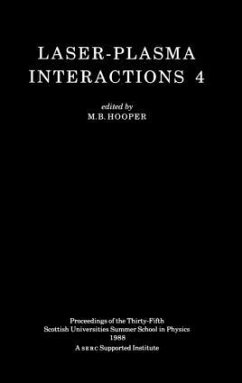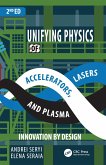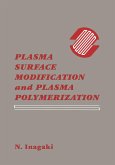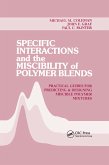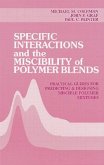Laser-Plasma Interactions 4
Herausgeber: Hooper, M. B
Laser-Plasma Interactions 4
Herausgeber: Hooper, M. B
- Gebundenes Buch
- Merkliste
- Auf die Merkliste
- Bewerten Bewerten
- Teilen
- Produkt teilen
- Produkterinnerung
- Produkterinnerung
Laser-Plasma Interactions 4 is the fourth book in a series devoted to the study of laser-plasma interactions. Subjects covered include laser light propagation, instabilities, compression and hydrodynamics, spectroscopy, diagnostics, computer code, dense plasmas, high-power lasers, X-UV sources and lasers, beat waves, and transport processes.
Andere Kunden interessierten sich auch für
![Unifying Physics of Accelerators, Lasers and Plasma Unifying Physics of Accelerators, Lasers and Plasma]() Andrei SeryiUnifying Physics of Accelerators, Lasers and Plasma178,99 €
Andrei SeryiUnifying Physics of Accelerators, Lasers and Plasma178,99 €![Plasma Surface Modification and Plasma Polymerization Plasma Surface Modification and Plasma Polymerization]() Norihiro InagakiPlasma Surface Modification and Plasma Polymerization278,99 €
Norihiro InagakiPlasma Surface Modification and Plasma Polymerization278,99 €![Transport and Interactions of Chlorides in Cement-based Materials Transport and Interactions of Chlorides in Cement-based Materials]() Caijun ShiTransport and Interactions of Chlorides in Cement-based Materials60,99 €
Caijun ShiTransport and Interactions of Chlorides in Cement-based Materials60,99 €![Specific Interactions and the Miscibility of Polymer Blends Specific Interactions and the Miscibility of Polymer Blends]() Michael M. ColemanSpecific Interactions and the Miscibility of Polymer Blends82,99 €
Michael M. ColemanSpecific Interactions and the Miscibility of Polymer Blends82,99 €![Specific Interactions and the Miscibility of Polymer Blends Specific Interactions and the Miscibility of Polymer Blends]() Michael M. ColemanSpecific Interactions and the Miscibility of Polymer Blends188,99 €
Michael M. ColemanSpecific Interactions and the Miscibility of Polymer Blends188,99 €![Laser-Material Interactions at Micro/Nanoscales Laser-Material Interactions at Micro/Nanoscales]() Laser-Material Interactions at Micro/Nanoscales94,99 €
Laser-Material Interactions at Micro/Nanoscales94,99 €![Laser-Solid Interactions for Materials Processing Laser-Solid Interactions for Materials Processing]() Laser-Solid Interactions for Materials Processing35,99 €
Laser-Solid Interactions for Materials Processing35,99 €-
-
-
Laser-Plasma Interactions 4 is the fourth book in a series devoted to the study of laser-plasma interactions. Subjects covered include laser light propagation, instabilities, compression and hydrodynamics, spectroscopy, diagnostics, computer code, dense plasmas, high-power lasers, X-UV sources and lasers, beat waves, and transport processes.
Produktdetails
- Produktdetails
- Verlag: CRC Press
- Seitenzahl: 400
- Erscheinungstermin: 1. Januar 1989
- Englisch
- Abmessung: 240mm x 161mm x 26mm
- Gewicht: 763g
- ISBN-13: 9780905945187
- ISBN-10: 0905945182
- Artikelnr.: 23516196
- Herstellerkennzeichnung
- Libri GmbH
- Europaallee 1
- 36244 Bad Hersfeld
- gpsr@libri.de
- Verlag: CRC Press
- Seitenzahl: 400
- Erscheinungstermin: 1. Januar 1989
- Englisch
- Abmessung: 240mm x 161mm x 26mm
- Gewicht: 763g
- ISBN-13: 9780905945187
- ISBN-10: 0905945182
- Artikelnr.: 23516196
- Herstellerkennzeichnung
- Libri GmbH
- Europaallee 1
- 36244 Bad Hersfeld
- gpsr@libri.de
Dr M B Hooper, Department of Physics and Applied Physics, University of Strathclyde, Glasgow G4 ONG, Scotland, UK.
INTRODUCTION TO THE PHYSICS AND APPLICATIONS OF LASER PRODUCED PLASMAS
M H KEY
INTRODUCTION
1. LASER FUSION
Direct drive
Indirect drive
Comparison of inertial fusion and magnetic fusion Future facilities
2. DENSE PLASMAS
3. HIGH INTENSITY LASER PLASMA INTERACTIONS
4. PARTICLE ACCELERATORS Wake field acceleration
5. XUV AND X
RAY SOURCES AND THEIR APPLICATIONS
6. XUV AND X
RAY LASERS
7. PARTICLE SOURCES
8. DEVELOPMENTS IN LASER TECHNOLOGY
REFERENCES
LASER LIGHT PROPAGATION AND INTERACTION WITH PLASMA
P. MULSER
1. CAPACITOR MODEL OF RESONANCE ABSORPTION
1.1 Linear resonance absorption
1.2 High amplitude electron waves and wavebreaking
2. ABSORPTION OF INTENSE fs LASER PULSES
2.1 Plasma parameters and the problem of absorption
2.2 Collision frequency under strong drift conditions
Excitation of plasma oscillations by a single fast particle
Collision frequencies
Screening and statistical independence
2.3 Anomalous skin effect
2.4 Ionisation dephasing
3. WAVE ACTION AND PROPAGATION IN MODULATED PLASMAS
3.1 Generalized ponderomotive action on single particles
3.2 Light propagation in periodically modulated plasmas REFERENCES
LASER
INDUCED RADIATION HYDRODYNAMICS: AN INTRODUCTION
R. SIGEL
1. INTRODUCTION
2. RADIATIVE TRANSPORT
2.1 Radiation confinement
2.2 The hydrodynamic equations
2.3 The transport'of energy by radiation 2.4 The maximum opacity theorem
3. SELF
SIMILAR SOLUTIONS
3.1 The Buckingham theorem and self
similarity
3.2 The isothermal rarefaction wave as an example of self
similar gas motion
3.3 The radiation driven ablative heat wave
4. EXPERIMENTS REFERENCES
LASER
DRIVEN INSTABILITIES IN LONG SCALELENGTH PLASMAS
II
W L KRUER
1. INTRODUCTION
2. STIMULATED RAMAN SCATTERING
3. EFFECT OF ION FLUCTUATIONS ON SRS
4. LASER BEAM FILAMENTATION
5. LASER BEAM SMOOTHING
6. SUMMARY REFERENCES
SPECTROSCOPY AND ATOMIC PHYSI
M H KEY
INTRODUCTION
1. LASER FUSION
Direct drive
Indirect drive
Comparison of inertial fusion and magnetic fusion Future facilities
2. DENSE PLASMAS
3. HIGH INTENSITY LASER PLASMA INTERACTIONS
4. PARTICLE ACCELERATORS Wake field acceleration
5. XUV AND X
RAY SOURCES AND THEIR APPLICATIONS
6. XUV AND X
RAY LASERS
7. PARTICLE SOURCES
8. DEVELOPMENTS IN LASER TECHNOLOGY
REFERENCES
LASER LIGHT PROPAGATION AND INTERACTION WITH PLASMA
P. MULSER
1. CAPACITOR MODEL OF RESONANCE ABSORPTION
1.1 Linear resonance absorption
1.2 High amplitude electron waves and wavebreaking
2. ABSORPTION OF INTENSE fs LASER PULSES
2.1 Plasma parameters and the problem of absorption
2.2 Collision frequency under strong drift conditions
Excitation of plasma oscillations by a single fast particle
Collision frequencies
Screening and statistical independence
2.3 Anomalous skin effect
2.4 Ionisation dephasing
3. WAVE ACTION AND PROPAGATION IN MODULATED PLASMAS
3.1 Generalized ponderomotive action on single particles
3.2 Light propagation in periodically modulated plasmas REFERENCES
LASER
INDUCED RADIATION HYDRODYNAMICS: AN INTRODUCTION
R. SIGEL
1. INTRODUCTION
2. RADIATIVE TRANSPORT
2.1 Radiation confinement
2.2 The hydrodynamic equations
2.3 The transport'of energy by radiation 2.4 The maximum opacity theorem
3. SELF
SIMILAR SOLUTIONS
3.1 The Buckingham theorem and self
similarity
3.2 The isothermal rarefaction wave as an example of self
similar gas motion
3.3 The radiation driven ablative heat wave
4. EXPERIMENTS REFERENCES
LASER
DRIVEN INSTABILITIES IN LONG SCALELENGTH PLASMAS
II
W L KRUER
1. INTRODUCTION
2. STIMULATED RAMAN SCATTERING
3. EFFECT OF ION FLUCTUATIONS ON SRS
4. LASER BEAM FILAMENTATION
5. LASER BEAM SMOOTHING
6. SUMMARY REFERENCES
SPECTROSCOPY AND ATOMIC PHYSI
INTRODUCTION TO THE PHYSICS AND APPLICATIONS OF LASER PRODUCED PLASMAS
M H KEY
INTRODUCTION
1. LASER FUSION
Direct drive
Indirect drive
Comparison of inertial fusion and magnetic fusion Future facilities
2. DENSE PLASMAS
3. HIGH INTENSITY LASER PLASMA INTERACTIONS
4. PARTICLE ACCELERATORS Wake field acceleration
5. XUV AND X
RAY SOURCES AND THEIR APPLICATIONS
6. XUV AND X
RAY LASERS
7. PARTICLE SOURCES
8. DEVELOPMENTS IN LASER TECHNOLOGY
REFERENCES
LASER LIGHT PROPAGATION AND INTERACTION WITH PLASMA
P. MULSER
1. CAPACITOR MODEL OF RESONANCE ABSORPTION
1.1 Linear resonance absorption
1.2 High amplitude electron waves and wavebreaking
2. ABSORPTION OF INTENSE fs LASER PULSES
2.1 Plasma parameters and the problem of absorption
2.2 Collision frequency under strong drift conditions
Excitation of plasma oscillations by a single fast particle
Collision frequencies
Screening and statistical independence
2.3 Anomalous skin effect
2.4 Ionisation dephasing
3. WAVE ACTION AND PROPAGATION IN MODULATED PLASMAS
3.1 Generalized ponderomotive action on single particles
3.2 Light propagation in periodically modulated plasmas REFERENCES
LASER
INDUCED RADIATION HYDRODYNAMICS: AN INTRODUCTION
R. SIGEL
1. INTRODUCTION
2. RADIATIVE TRANSPORT
2.1 Radiation confinement
2.2 The hydrodynamic equations
2.3 The transport'of energy by radiation 2.4 The maximum opacity theorem
3. SELF
SIMILAR SOLUTIONS
3.1 The Buckingham theorem and self
similarity
3.2 The isothermal rarefaction wave as an example of self
similar gas motion
3.3 The radiation driven ablative heat wave
4. EXPERIMENTS REFERENCES
LASER
DRIVEN INSTABILITIES IN LONG SCALELENGTH PLASMAS
II
W L KRUER
1. INTRODUCTION
2. STIMULATED RAMAN SCATTERING
3. EFFECT OF ION FLUCTUATIONS ON SRS
4. LASER BEAM FILAMENTATION
5. LASER BEAM SMOOTHING
6. SUMMARY REFERENCES
SPECTROSCOPY AND ATOMIC PHYSI
M H KEY
INTRODUCTION
1. LASER FUSION
Direct drive
Indirect drive
Comparison of inertial fusion and magnetic fusion Future facilities
2. DENSE PLASMAS
3. HIGH INTENSITY LASER PLASMA INTERACTIONS
4. PARTICLE ACCELERATORS Wake field acceleration
5. XUV AND X
RAY SOURCES AND THEIR APPLICATIONS
6. XUV AND X
RAY LASERS
7. PARTICLE SOURCES
8. DEVELOPMENTS IN LASER TECHNOLOGY
REFERENCES
LASER LIGHT PROPAGATION AND INTERACTION WITH PLASMA
P. MULSER
1. CAPACITOR MODEL OF RESONANCE ABSORPTION
1.1 Linear resonance absorption
1.2 High amplitude electron waves and wavebreaking
2. ABSORPTION OF INTENSE fs LASER PULSES
2.1 Plasma parameters and the problem of absorption
2.2 Collision frequency under strong drift conditions
Excitation of plasma oscillations by a single fast particle
Collision frequencies
Screening and statistical independence
2.3 Anomalous skin effect
2.4 Ionisation dephasing
3. WAVE ACTION AND PROPAGATION IN MODULATED PLASMAS
3.1 Generalized ponderomotive action on single particles
3.2 Light propagation in periodically modulated plasmas REFERENCES
LASER
INDUCED RADIATION HYDRODYNAMICS: AN INTRODUCTION
R. SIGEL
1. INTRODUCTION
2. RADIATIVE TRANSPORT
2.1 Radiation confinement
2.2 The hydrodynamic equations
2.3 The transport'of energy by radiation 2.4 The maximum opacity theorem
3. SELF
SIMILAR SOLUTIONS
3.1 The Buckingham theorem and self
similarity
3.2 The isothermal rarefaction wave as an example of self
similar gas motion
3.3 The radiation driven ablative heat wave
4. EXPERIMENTS REFERENCES
LASER
DRIVEN INSTABILITIES IN LONG SCALELENGTH PLASMAS
II
W L KRUER
1. INTRODUCTION
2. STIMULATED RAMAN SCATTERING
3. EFFECT OF ION FLUCTUATIONS ON SRS
4. LASER BEAM FILAMENTATION
5. LASER BEAM SMOOTHING
6. SUMMARY REFERENCES
SPECTROSCOPY AND ATOMIC PHYSI

